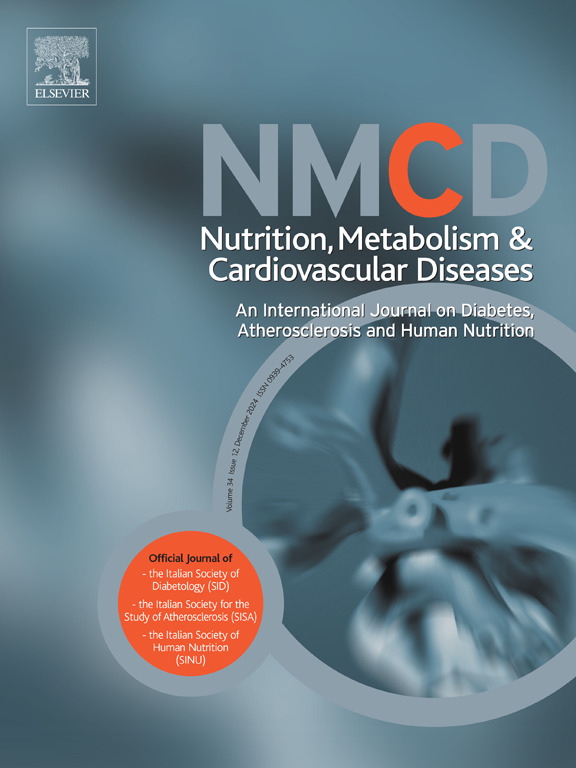营养状况与心力衰竭及射血分数改善之间的关系。
IF 3.7
3区 医学
Q2 CARDIAC & CARDIOVASCULAR SYSTEMS
Nutrition Metabolism and Cardiovascular Diseases
Pub Date : 2025-04-11
DOI:10.1016/j.numecd.2025.104035
引用次数: 0
摘要
背景和目的:一部分伴有射血分数降低(HFrEF)的心力衰竭患者可能会经历射血分数的改善,称为HFimpEF。营养不良是与心衰患者不良预后相关的常见疾病。然而,营养状况与HFimpEF之间的关系尚不清楚。方法和结果:回顾性纳入1057例HFrEF住院患者。患者被分为HFimpEF(定义为随访efbb0 40%和≥10%的绝对增加)或持续性HFrEF。采用预后营养指数(PNI)、老年营养风险指数(GNRI)和控制营养状况指数(CONUT)评价营养状况。采用Logistic回归和限制性三次样条法评估营养状况与HFimpEF之间的关系。1057例患者(平均年龄64.00岁,男性72.94%)中,418例(39.55%)发生HFimpEF。多因素调整后,营养指标的评分增加与HFimpEF相关[PNI, OR (95% CI): 1.03 (1.01-1.06);Gnri, or (95% ci): 1.02 (1.01-1.04);(95% ci): 0.89(0.83-0.96)]。限制三次样条曲线显示营养指标与HFimpEF呈线性相关(非线性P < 0.05)。在基本模型中加入CONUT评分对HFimpEF预测的增量效应最为显著[曲线下面积= 0.698;连续净重分类改进:0.191 (0.068-0.313);综合判别改善:0.009(0.004-0.015)]。结论:营养不良与HFimpEF的发生有关。营养状况的评估可能为HFimpEF的预测提供增量价值。本文章由计算机程序翻译,如有差异,请以英文原文为准。
Association between nutritional status and heart failure with improved ejection fraction
Background and aims
A proportion of patients with heart failure with reduced ejection fraction (HFrEF) may experience an improvement in ejection fraction, termed HFimpEF. Malnutrition is a common condition associated with adverse prognosis in HF patients. However, the association between nutritional status and HFimpEF remains unclear.
Methods and results
A total of 1057 hospitalized patients with HFrEF were retrospectively enrolled. Patients were grouped into HFimpEF (defined as follow-up EF>40 % and ≥10 % absolute increase) or persistent HFrEF. Nutritional status was assessed by prognostic nutritional index (PNI), geriatric nutritional risk index (GNRI) and controlling nutritional status index (CONUT). Logistic regression and restricted cubic splines were conducted to assess the association between nutritional status and HFimpEF. Among 1057 patients (mean age 64.00 years, 72.94 % male), 418 (39.55 %) developed HFimpEF. After multivariate adjustment, a per-score increase of nutritional indices was associated with HFimpEF [PNI, OR (95 % CI): 1.03 (1.01–1.06); GNRI, OR (95 % CI): 1.02 (1.01–1.04); CONUT, OR (95 % CI): 0.89 (0.83–0.96)]. The restricted cubic splines revealed linear associations between nutritional indices and HFimpEF (P for non-linearity >0.05). The addition of the CONUT score to the basic model had the most significant incremental effect on the prediction for HFimpEF [area under the curve = 0.698; continuous net reclassification improvement: 0.191 (0.068–0.313); integrated discrimination improvement: 0.009 (0.004–0.015)].
Conclusion
Malnutrition is associated with the development of HFimpEF. Assessment of nutritional status may provide incremental value for the prediction of HFimpEF.
求助全文
通过发布文献求助,成功后即可免费获取论文全文。
去求助
来源期刊
CiteScore
6.80
自引率
2.60%
发文量
332
审稿时长
57 days
期刊介绍:
Nutrition, Metabolism & Cardiovascular Diseases is a forum designed to focus on the powerful interplay between nutritional and metabolic alterations, and cardiovascular disorders. It aims to be a highly qualified tool to help refine strategies against the nutrition-related epidemics of metabolic and cardiovascular diseases. By presenting original clinical and experimental findings, it introduces readers and authors into a rapidly developing area of clinical and preventive medicine, including also vascular biology. Of particular concern are the origins, the mechanisms and the means to prevent and control diabetes, atherosclerosis, hypertension, and other nutrition-related diseases.

 求助内容:
求助内容: 应助结果提醒方式:
应助结果提醒方式:


